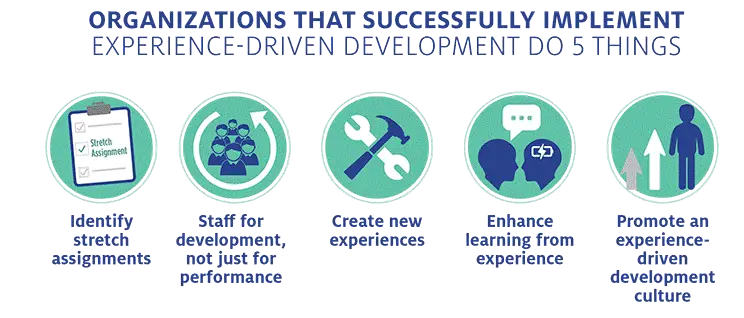Putting Experience at the Center of Talent Management
Monday, September 17, 2018
As business landscapes continue to change and shift, talent management leaders face recurring questions:
Can leaders be developed quickly enough to meet demand?
Could leaders better take advantage of current talent management processes and efforts?
How can we help line managers develop and manage talent more effectively?
Learning from experience is the best way to develop talent. Yet most organizations aren’t maximizing on-the-job opportunities that prepare leaders, develop employees, and advance business goals.
The key is to make experience-driven leader development intentional.
HR leaders understand this and often follow the 70-20-10 framework:
- 70% of learning comes from on-the-job experiences and challenges.
- 20% of learning comes from other people.
- 10% of learning comes from courses and formal training.
Experience-driven talent management is when experience — carefully designed and executed — becomes the core driver of learning in the organization.
Working and learning are no longer separated. Instead, they’re bound together, aligned with the business strategy and shaped by a talent strategy
When this kind of development is part of the organizational culture and embedded in all of talent management, you’ll see things such as senior leaders who support stretch assignments as a key strategy for developing employees, highly-valued employees being routinely shared with other parts of the organization, and development opportunities considered when making decisions about how to staff key projects.
Putting experience-driven development at the center of talent management will boost an organization’s efforts to attract and retain talent, and accelerate the development of leaders at every level.
 Organizations that successfully implement experience-driven development do these 5 things:
1. Identify stretch assignments. Some experiences are more developmental than others. Identifying stretch assignments includes:
- Developing a shared language for talking about stretch assignments.
- Mapping competencies to stretch assignments.
- Creating experience paths for targeted positions or roles — such as a general manager role or those on a high-potential track.
- Reserving specific key jobs to use for development only.
2. Staff for development, not just performance. Matching specific individuals with the right experience requires rigor. The key with experience-driven development is to consider the need to hone new skills and perspectives, not simply making assignments based on past success or current role. Staffing for development includes:
- Putting processes in place to identify the next assignment needed for each high-potential to continue broadening their portfolio of experience.
- Making sure that everyone has a “development-in-place” assignment — something in their current job that challenges and supports targeted development.
- Staffing key projects with development in mind, asking, “Who could benefit from this experience?”
- Developing managers’ skills at assignment-based development to be sure they’re able to identify, implement, and support stretch assignments.
3. Create new experiences. This requires that enough of the right experiences exist to develop people in the needed ways. Expanding the array of developmental assignments involves:
- Creating new types of experiences to meet strategic needs of the organization — more cross-functional, cross-country, new market, and new client opportunities, for example.
- Including developmental assignments in formal development programs — this might be in the form of action-learning projects, special assignments, or job-rotation experiences.
- Supporting the pursuit of leadership experiences beyond the workplace, such as volunteer work, board membership, or roles with professional organizations that address development needed in the workplace.
4. Enhance learning from experience. Going through an experience doesn’t guarantee a person will learn from it. Support is essential. Organizations need to surround work development experiences with effective learning practices, including:
- Tools for reflecting on experience and feedback.
- Access to relationships for learning such as mentors, peer networks, and communities of practice.
- Coaches who challenge and support explicit learning goals and experience-driven development.
- Formal coursework and online resources that provide just-in-time learning tailored to the challenges of the specific stretch experience.
5. Promote an experience-driven development culture. When learning from experience is embedded in the culture, the gap between doing the work and developing the people shrinks. Learning isn’t added on — nor is coaching and aligning talent. An experience-driven development culture includes:
- Hiring, developing, recognizing, and rewarding senior leaders who visibly support experience-driven development.
- Communicating and tracking on-the-job development.
- Rewarding employees for their own development and for developing others.
- Valuing learning agility as a core competency — recruiting for it, selecting for it, and developing it.
Learning opportunities are everywhere and everyone knows it. The purpose of talent management, then, is to help individuals notice what should and could be learned from experience and to find ways to help the organization capitalize on that learning potential.
By facilitating a shift in mindset and culture, along with changes in strategy, process, and roles, the talent management function can improve the process of attracting and retaining talent, and developing leaders.
Source: Centre for Creative Leadership White Paper on Putting Experience at the Centre of Talent Management.
Organizations that successfully implement experience-driven development do these 5 things:
1. Identify stretch assignments. Some experiences are more developmental than others. Identifying stretch assignments includes:
- Developing a shared language for talking about stretch assignments.
- Mapping competencies to stretch assignments.
- Creating experience paths for targeted positions or roles — such as a general manager role or those on a high-potential track.
- Reserving specific key jobs to use for development only.
2. Staff for development, not just performance. Matching specific individuals with the right experience requires rigor. The key with experience-driven development is to consider the need to hone new skills and perspectives, not simply making assignments based on past success or current role. Staffing for development includes:
- Putting processes in place to identify the next assignment needed for each high-potential to continue broadening their portfolio of experience.
- Making sure that everyone has a “development-in-place” assignment — something in their current job that challenges and supports targeted development.
- Staffing key projects with development in mind, asking, “Who could benefit from this experience?”
- Developing managers’ skills at assignment-based development to be sure they’re able to identify, implement, and support stretch assignments.
3. Create new experiences. This requires that enough of the right experiences exist to develop people in the needed ways. Expanding the array of developmental assignments involves:
- Creating new types of experiences to meet strategic needs of the organization — more cross-functional, cross-country, new market, and new client opportunities, for example.
- Including developmental assignments in formal development programs — this might be in the form of action-learning projects, special assignments, or job-rotation experiences.
- Supporting the pursuit of leadership experiences beyond the workplace, such as volunteer work, board membership, or roles with professional organizations that address development needed in the workplace.
4. Enhance learning from experience. Going through an experience doesn’t guarantee a person will learn from it. Support is essential. Organizations need to surround work development experiences with effective learning practices, including:
- Tools for reflecting on experience and feedback.
- Access to relationships for learning such as mentors, peer networks, and communities of practice.
- Coaches who challenge and support explicit learning goals and experience-driven development.
- Formal coursework and online resources that provide just-in-time learning tailored to the challenges of the specific stretch experience.
5. Promote an experience-driven development culture. When learning from experience is embedded in the culture, the gap between doing the work and developing the people shrinks. Learning isn’t added on — nor is coaching and aligning talent. An experience-driven development culture includes:
- Hiring, developing, recognizing, and rewarding senior leaders who visibly support experience-driven development.
- Communicating and tracking on-the-job development.
- Rewarding employees for their own development and for developing others.
- Valuing learning agility as a core competency — recruiting for it, selecting for it, and developing it.
Learning opportunities are everywhere and everyone knows it. The purpose of talent management, then, is to help individuals notice what should and could be learned from experience and to find ways to help the organization capitalize on that learning potential.
By facilitating a shift in mindset and culture, along with changes in strategy, process, and roles, the talent management function can improve the process of attracting and retaining talent, and developing leaders.
Source: Centre for Creative Leadership White Paper on Putting Experience at the Centre of Talent Management.












